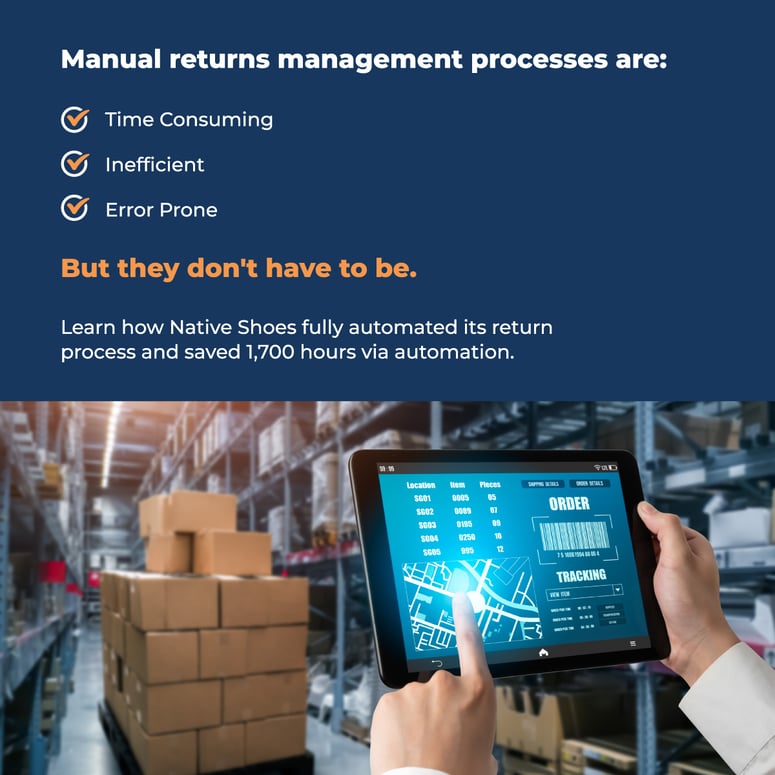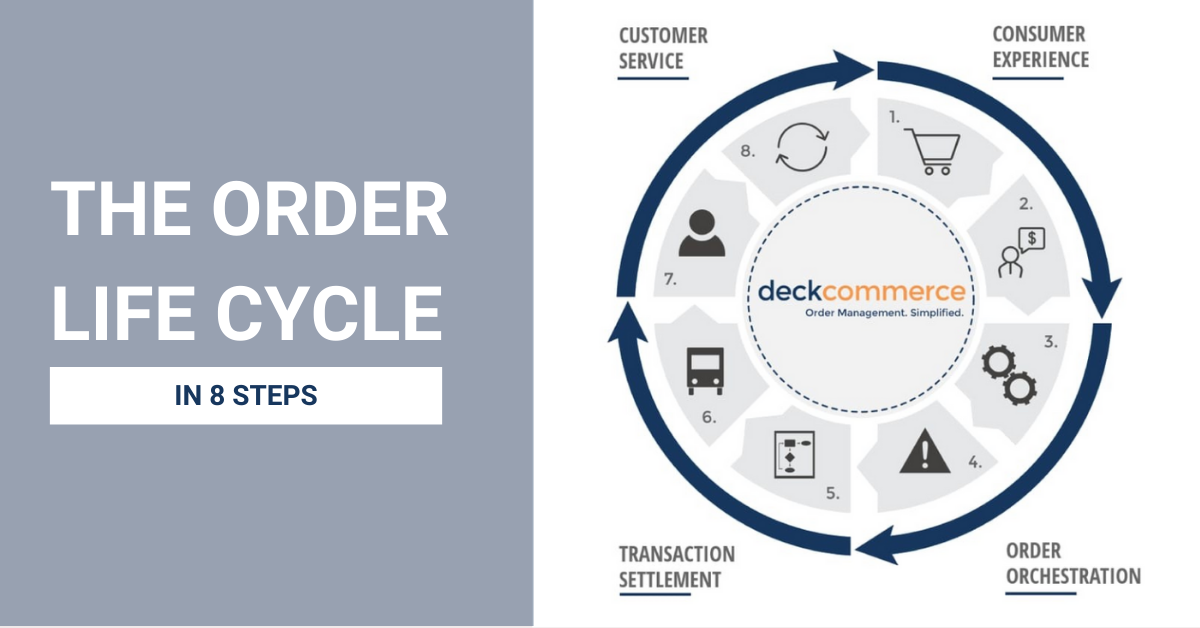
Did you know a whopping 75% of shoppers think returns are the most painful part of buying online? And in today’s world, an outstanding customer experience is expected well beyond your digital and physical storefronts – through the entire order lifecycle.
After you perfect your shopping experiences to convert the most customers, there are still several things that need to happen to keep your best customers returning to shop. While consumer expectations skyrocket and ecommerce orders soar, the importance of a smooth returns experience is becoming more important for retailers that want to retain customers.
Payment processing, shipping, and delivery are all important post-purchase touchpoints for your customer experience, but the returns process can be one of the most pivotal moments in a relationship with even your best customers. Returns don’t have to be a point of frustration for your customers. With the right process and OMS technology in place, returns can become a point of retention.
Here are the best ways to keep returns customer-centric, outlining ecommerce returns best practices, and ensuring your best customers will keep coming back for more.
1. Offer easy-to-initiate returns
Help your customers help themselves. The less time they spend jumping through hoops to start a return, the better. Give them options that will make starting their return easier and pain-free whether it’s online, in store, or with help from your customer service team.
Online Returns – Fast & Easy
An online self-service returns page is a must-have for ecommerce returns management and smooth customer experience. The returns page should make it easy for the customer to see how much will be returned for each item they’re returning and allow them to provide feedback on the reason for the return. This allows you to collect data for your teams on why the return was initiated (sizing issue, doesn’t match the description, etc.), while the customer feels heard airing any grievances. This return feedback can help you improve how you market products and prevent unnecessary returns in the future. (More on that later!)
Omnichannel Returns – Drive Upsell Opportunity (BORIS)
Did you know a quarter of US adults find dropping off packages at a mail facility the most frustrating part of retail returns? If your customer is running errands near one of your stores, it might be easier for them to pop in and return the item in the store itself. In fact, 61% of online shoppers prefer to return their item in store (buy online, return in store or BORIS).
While the customer is in the store, store associates can offer an exchange or upsell for a similar product that meets the customers’ needs. This is a win-win because no shipping costs are incurred, the sale is saved, and the customer is wow-ed by how well your brand understands them.
Customer Service – Encourage the Human Factor
Live chat, over the phone, or via email – there are so many ways customer service teams can help customers with returns. And a staggering 83% of US shoppers prefer to deal with humans, rather than digital channels, when it comes to customer service issues. Some people prefer human interaction during a return, whether they’re upset and need to vent, or they want to see how an issue can be quickly corrected.
Train your customer service team to be empathetic with a customer-first approach and give them the tools they need – like ability to exchange items within an order, credit shipping, retrigger transactional emails, and easily return items – so their personal interactions run smoothly.
Once you’ve determined how you want customers to initiate returns, make it clear on your website, email confirmations, receipts, and packing slips where the customer can go to get the process started.
2. Communicate throughout every step in the process
Just like you give customers status updates (email confirmations, text alerts, etc.) after an order is placed, you should also give them status updates after a return is initiated.
The customer should have visibility into all data your team has access to – return tracking information, credit confirmation, reasons a return is rejected, etc. Transparency is key throughout the entire order lifecycle. Any transaction after a return is started should be displayed on an online customer account status page, so customers can easily see all return updates in one place.
Enhancing Communication with Interactive Elements:
To further enhance the customer return process, consider adding interactive elements to your website. These tools can educate customers about the returns process and help in setting the right expectations. Here are a few suggestions:
- Interactive Return Process Guides: Create step-by-step guides using animations or graphics, showing customers exactly how to initiate and track their returns.
- Return Reason Quizzes: Implement short quizzes for customers to determine the best return options based on their specific situation.
- Infographic Displays: Use infographics to visually represent the return timeline, including what happens after an item is returned.
- FAQ Interactive Sections: Develop an interactive FAQ section where customers can click on commonly asked questions about returns to see detailed answers.
By incorporating these interactive elements, you can make the return process more engaging and informative, leading to a better understanding and satisfaction among customers.
3. Prevent future returns by analyzing return data
Collecting customer data for return reasons is critical for improving your product and reducing future returns overall. Whether a return is made online, in store, or with help from your customer service team, return reasons should be aggregated in your order management system and analyzed periodically to determine where change is needed.
For example, if everyone that returned their green sweater thought the image online looked forest green, but the sweater is really mint green, you should be able to see this trend through your return reasons and can update the photos to display a more accurate color. If your data shows everyone that returned their green sweater said it was itchy, a change in material for future products should be considered.
Leveraging Return Data for Comprehensive Insights
Beyond pinpointing specific product issues, analyzing customer return data offers a broader view of consumer preferences and behavior. For example, a notable volume of returns due to sizing inconsistencies might suggest the need to revise size charts or enhance product measurements on your website.
Let's explore how a detailed analysis of return data can lead to significant improvements across various aspects of your business.
Trend Analysis
This involves examining return data over time to identify patterns or recurring issues. For example, if a particular style or product sees higher return rates seasonally, this insight can guide inventory planning and marketing efforts. Analyzing trends can also uncover broader market shifts or evolving customer preferences, allowing for proactive adjustments in product offerings.
Customer Feedback Integration
Incorporating customer feedback received during the return process is important. Feedback provides direct insights into customer expectations and dissatisfaction points. Feedback can also highlight issues in sizing, packaging, or even marketing misalignments. This direct input from customers can be invaluable in refining product features, descriptions, and even guiding future product development.
Return Rate Metrics
Keeping track of return rates by product, category, or customer segment can highlight areas needing improvement. High return rates in a particular category might indicate a need for better product descriptions, images, or quality checks. Analyzing these metrics helps in identifying not just the 'what' but the 'why' behind returns, enabling targeted strategies to enhance product satisfaction and reduce return rates.
Case Studies
Including real-life examples or case studies can illustrate how businesses have successfully used return data to reduce their return rates and improve customer satisfaction. These case studies can show practical applications of data analysis in various contexts, such as adjusting product designs, enhancing customer service protocols, or tweaking marketing strategies based on return data insights.
4. Make returns faster & more reliable with automation
Your customer deserves a fast and reliable experience in customer returns handling, and if your team is still processing returns manually one by one – the risk of human error and a slow returns process increases exponentially
With the right ecommerce returns solutions, automating nearly every step of the returns process becomes possible, significantly limiting the need for manual intervention to just restocking. Automation not only reduces the time your team spends on the returns management process but also enhances customer satisfaction.
The resulting smoother returns experience can lead to an increase in repeat customers. Moreover, automation brings several benefits:
- Increased Accuracy: Automated systems reduce the number of errors in processing returns, leading to more accurate handling of refunds and restocking.
- Better Data Management: Automated returns software can provide valuable data analytics, offering insights into return patterns and customer behavior.
- Cost Effective: Automation can reduce the labor and operational costs associated with manual return processes.
- Scalability: Automated systems can easily handle large numbers of returns, making them ideal for growing businesses.
- Consistency in Service: Automation ensures a consistent return experience for all customers, regardless of volume or complexity.
- Real-Time Updates: Keeping customers informed in real-time about the status of their return enhances transparency and builds trust.
Comparing Customer Returns Software Solutions
Features |
Narvar |
Optoro |
Shopify Returns Manager |
Happy Returns |
|
Return Label Generation |
Standard |
Automated |
Automated |
Automated |
|
Real-Time Tracking |
Robust |
Standard |
Standard |
Standard |
|
OMS Integration |
Limited |
Seamless |
Good for Shopify |
Standard |
|
Advanced Analytics |
Good |
Advanced |
Standard |
Comprehensive |
|
Customer Support |
Good |
Excellent |
Good |
Very Good |
|
Customization Options |
Moderate |
High |
Moderate |
High |
|
Mobile Accessibility |
Yes |
Yes |
Yes |
Yes |
5. One brand, one return policy across channels
Uniformity in your return policy across all channels is a necessity in retail. A staggering 71% of consumers expect a consistent experience regardless of the shopping channel, yet only 29% report receiving such consistency. This gap highlights a significant opportunity for retailers.
Ensuring that your return policies are consistent across all platforms – whether online, in-store, or through third-party marketplaces – is crucial. Customers should encounter the same terms, conditions, and ease of process regardless of where they make their purchase. This uniformity helps in building customer trust and loyalty.
Here are ways to ensure consistency in your return policies:
- Clear Communication: Use simple and unambiguous language to describe your return policy. Make it easily accessible on all platforms, such as your website, social media, in-store signage, and customer service scripts.
- Training and Alignment: Ensure that all staff, from store associates to online customer service representatives, are thoroughly trained and aligned on the return policy. Consistency in how your team handles returns is as important as the policy itself.
- Feedback Loop: Regularly gather feedback from customers and front-line staff about the return process. Use this feedback to refine and adjust policies, ensuring they meet customer needs and are easy to follow.
- Technology Integration: Utilize technology like a unified OMS to manage returns across all channels efficiently. This can help in tracking and maintaining consistency in handling returns, regardless of the purchase origin.
- Periodic Review and Update: Regularly review your return policy for relevance and clarity. Market trends and customer expectations evolve, and your policy should evolve too.
By implementing a consistent return policy across all channels, you reduce confusion and frustration for both customers and staff. It results in a smoother, more predictable experience that can significantly enhance customer satisfaction and foster long-term loyalty.
Summary
While a great storefront experience attracts customers initially, customers won’t become loyal if they have a poor experience returning an item. Thinking beyond your storefront experience – optimizing every touchpoint through the order lifecycle – is critical for long-term customer retention, even for your most loyal customers.
By making returns easy and transparent, you reassure customers that you value their satisfaction above all. Your effort in optimizing returns will pay off in the form of happy, loyal customers who are eager to come back.
Looking for more information on returns? Check out ➡️ How an OMS Optimizes the Returns Process.









.png?width=2000&height=2000&name=Blog%20Directory%20CTA%202000x2000%20px%20(2).png)






.png?width=2000&height=2000&name=Blog%20Directory%20CTA%202000x2000%20px%20(3).png)
